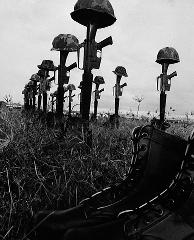
Memorandum From the Commander in Chief, Pacific (Felt) to the Joint Chiefs of Staff (1)Thanks to David Fuhrmann for supplying this document.CINCPAC 3010. Ser. 00447-63 Honolulu, May 11, 1963.
SUBJ.
Revised Plan for Republic of Vietnam
REF
(a) JCS msg 9820 DTG 0918052 May 1963 (2)
(b) CINCPAC msg DTG 1022462 May 1963 (3)
(c) USAF AFSMSB 60437 DTB 0916392 May 1963 NOTAL (4)
(d) CINCPAC msg DTG 1100172 May 1963 (5)ENCL (1) Outline Revised Plan for Republic of Vietnam
1. Pursuant to directives by the Secretary of Defense during the conference held in Honolulu on 6 May 1963 and guidance in reference (a), an outline revised plan has been prepared. The details of the plan will be developed within the guidelines of a force structure that the RVN budget can support with minimum U.S. MAP assistance, acceleration of RVNAF training for earlier takeover of U.S. equipment and functions, a realistic demobilization program to prevent economic chaos, and minimum forces necessary to cope with reinsurgency and permit timely introduction of U.S. forces in the event of overt aggression.
2. Assumptions:
a. The insurgency can be controlled by the end of CY 1965 (mid FY 66). Note: In my view, it is overly optimistic to assume that insurgency can be controlled as early as FY 65 as hopefully expressed in reference (a).3. The primary limiting factor affecting early withdrawal of U.S. special military assistance is the capability of RVN to provide sufficient personnel during FY 64-65 with required aptitudes for training as pilots, and technicians to operate and maintain equipment turned over to RVNAF.b. The necessary training aircraft (9 additional UH-19's and 25 Cessna 185's) and supporting U.S. training personnel will be available in RVN no later than 1 July 1963 to improve the in-country training capability.
c. The USAF and/or USN will provide 44 spaces during FY 63 for training T-28 pilots rather than slipping this program to FY 64 as proposed in reference (c). Reference (d) requested that USAF take necessary action in this regard.
d. Equipment required by RVNAF, such as AC&W, troposcatter, USMC helicopters, C-123 aircraft, and liaison aircraft, including spare parts and supporting equipment for operation of these items, will be turned over in place without cost to MAP as U.S. forces withdraw.
e. The Secretary of Defense will ensure that sufficient ammunition is provided on a timely basis from other than MAP resources as necessary to cover reductions which have been made in ammunition funding requests in compliance with SecDef directive. This situation applies also to other categories of supply such as expendables/ consumables.
f. Operational support of the troposcatter system (funded, installed and currently operated by the U.S. military services) will be assumed by AID in FY 66.
g. The Civil Guard and Self Defense Corps will revert to the Minister of Interior once the insurgency is under control.
h. A bilateral defense agreement will be made between the U.S. and the RVN to permit the reduction of RVN forces on the scale outlined in enclosure (1).
4. Plans for development and support of a National Police Force should be formulated now by AID for utilization of Civil Guard and Self Defense Corps assets to assure an orderly transition from martial to civil law. Paragraph 2g. is valid only if this is accomplished on a timely basis.
5. The FY 64-69 force structure and priority list for FY 64 were developed in consultation with COMUSMACV and CHMAAG Vietnam. The costing data was developed by representatives of CHMAAG Vietnam in coordination with my staff.
6. It is recommended that the Outline Revised Plan for Republic of Vietnam be approved as the basis for the refinement of the FY 64-69 MAP
H. D. Felt (6)
(1) Source: Washington National Records Center, RG 330, OSD Files: FRC 69 A 3131, Vietnam 091.3 MAP Secret. A marginal note on the source text indicates that a copy was sent to Secretary McNamara and he saw it.(2) An instruction to rework the plan in accordance with McNamara's objections was sent to Admiral Felt by the JCS on May 9. (Telegram JCS9820 to CINCPAC, May 9 [OSD Files, FRC 69 A 3131, VN 091.3 MAP 1963]. This telegram also instructed CINCPAC to prepare "as a matter of urgency" a plan for the withdrawal of 1000 U.S> troops from Vietnam before the end of the year. CINCPAC was instructed to bear in ming that Secretary McNamara felt that "the phase-out program persented during 6 May conference appeared too slow." CINCPAC was to develop a revised plan to achieve a more rapid phase-out of U.S. forces, with emphasis on the development of training plans to accelerate the replacement of U.S. by South Vietnamese units.
(3) In CINCPAC telegram 1022462 to RUEAHQ/HQ USAF, May 10, CINCPAC surveyed programs designed to build up the capabilities of South Vietnamese forces to permit the early release of U.S. units from Vietnam. These programs included helicopter training and liaison pilot training. (Washington National Records Center, RG 319, U.S. Army Message Center Microfilm, Reel 11331)
(4) Not found.
(5) In CINCPAC telegram 1100172 to RUEAHQ/HQ USAF, May 11, CINCPAC instructed the Air Force command to prevent an anticipated "slippage" in the training program for South Vietnamese pilots. (Washington National Records Center, RG 319, U.S. Army Message Center Microfilm, Reel 11331)
(6) Printed from a copy that bears this typed signature.